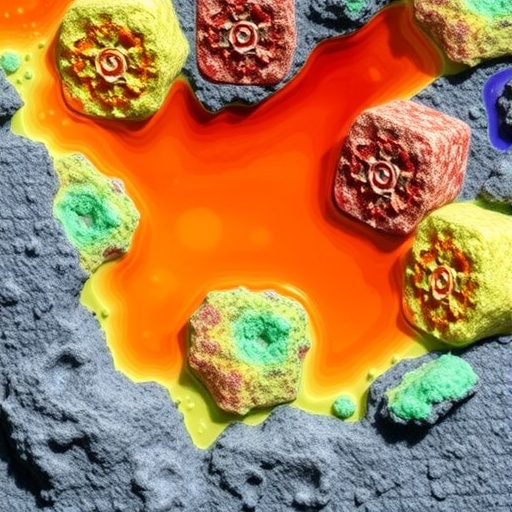In the realm of geoscience, the intricate dance between temperature and pressure parameters in the Earth’s crust is a fundamental aspect of understanding geological processes. A recent study conducted by Wang, Hou, Wieser, and colleagues sheds light on the reliability of mineral-based thermobarometers, tools critical for reconstructing the thermal and pressure conditions that played a role in the formation of rocks. This research not only enhances our understanding of mineral stability but also proposes a clear pathway to improved accuracy in geological models, ultimately benefiting a myriad of fields from resource exploration to environmental science.
The crux of the study hinges on the thermodynamic principles that govern the behaviour of minerals under varying conditions. Thermobarometers operate based on the assumption that the compositions of certain minerals can provide insight into the temperature and pressure at which they formed. By analyzing the composition of specific minerals, geoscientists can infer the conditions of the surrounding environment during the formation process. This relationship, however, is intricately complex and influenced by various factors, making the accurate interpretation of thermobarometric data a significant challenge.
Wang and his team conducted extensive experiments and calculations to assess the reliability of different thermobarometric methods. By employing state-of-the-art computational techniques, they were able to derive thermodynamic models that illustrate how specific minerals respond to changes in environmental conditions. Their findings suggest that while certain traditional thermobarometric equations remain useful, modern approaches incorporating advanced computational techniques significantly enhance accuracy and reliability.
One of the key breakthroughs of this research is the identification of mineral compositions that exhibit high stability across a broader range of conditions than previously understood. This characteristic is particularly important for constructing accurate thermodynamic models. The authors advocate for a reevaluation of existing thermobarometric methodologies, urging geoscientists to consider integrating these more stable mineral indicators into their analyses. This shift could dramatically improve interpretations of geological history, particularly in regions that have undergone multiple tectonic events.
Moreover, the research emphasizes the importance of experimental validation. The team employed high-pressure and high-temperature experiments to mimic the conditions under which these minerals form, collecting data that would serve to calibrate their computational models. This meticulous approach ensures that the proposed thermodynamic relationships not only hold theoretical merit but are also grounded in empirical evidence, elevating the credibility of their findings.
In addition to advancing scientific knowledge, this research holds significant implications for practical applications. For instance, accurate thermobarometry is crucial for the exploration of natural resources, such as oil and gas deposits. By better understanding the temperature and pressure conditions that lead to the formation of these resources, companies can refine their exploration strategies, potentially leading to a more efficient and sustainable extraction process.
The study also touches on the growing importance of mineral stability in the context of climate change. As geoscientists strive to assess the stability of minerals in various environments, understanding their thermodynamic properties becomes increasingly relevant. The insights from this research could inform models predicting how geological systems will respond to changing temperatures and pressures induced by climatic shifts, helping to mitigate potential environmental impacts.
Furthermore, educational institutions and research organizations could benefit from integrating these thermodynamic principles into their training programs. By equipping the next generation of geoscientists with a robust understanding of the relationships between temperature, pressure, and mineral stability, they can improve both fieldwork outcomes and theoretical advancements in the discipline.
The implications of this research extend beyond immediate geological applications. As our society increasingly grapples with the impacts of climate and environmental change, understanding the Earth’s geological processes through improved thermobarametric models could provide crucial insights into natural hazard monitoring and mitigation strategies. This could ultimately lead to enhanced public safety measures and better preparedness for geological events such as earthquakes and volcanic eruptions.
In conclusion, the research team led by Wang offers groundbreaking insights into the reliability of mineral-based thermobarometers, advocating for a shift towards more accurate methodologies that take into account the detailed thermodynamic behaviors of minerals. This study represents a significant advancement in geoscience and opens new pathways for research and application, promising to shape the future of geological investigations and resource management.
As the scientific community continues to explore these findings, it is clear that thermodynamic insights will play an essential role in unveiling the mysteries of our planet’s formation and its ongoing evolution. With greater precision in understanding the thermal and pressure conditions that shape Earth’s materials, we can better appreciate the complex history of our planet and the processes that will continue to influence it for eons to come.
Subject of Research: Thermodynamic insights into mineral-based thermobarometers.
Article Title: Thermodynamic insights into the reliability of mineral-based thermobarometers.
Article References:
Wang, X., Hou, T., Wieser, P.E. et al. Thermodynamic insights into the reliability of mineral-based thermobarometers. Commun Earth Environ 6, 913 (2025). https://doi.org/10.1038/s43247-025-02831-y
Image Credits: AI Generated
DOI: https://doi.org/10.1038/s43247-025-02831-y
Keywords: thermodynamics, mineral stability, thermobarometry, geochemistry, geological processes, resource exploration, environmental science.




